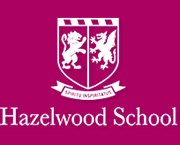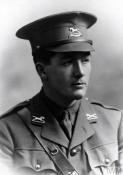
War Memorial
| Lieutenant Colonel John Cecil PETHERICK MC, Italian Silver Cross | |
|
B Squadron, 3rd (The King's Own) Hussars 4th Brigade Machine Gun Squadron (Cavalry) Date of birth: 21st January 1889 Date of death: 24th May 1981 Died aged 92 Buried at St Nicholas' Churchyard, Linton |

|
| John Cecil Petherick was born at 30 West Cromwell Road in London on the 21st of January 1889 the second son of George Tallack Petherick, a barrister at law, and Edith (nee Berryman) Petherick of Porthpean House, St Austell in Cornwall and of 18 Gledhow Gardens, London SW5. He was christened at St Philip's Church, Kensington on the 2nd of March 1889. He was educated at Hazelwood School until December 1902 where he was a member of the Choir and was Head of School. He was a member of the Cricket XI in 1902 when the school magazine wrote the following on his season: - "A useful bowler with an occasional swerve; had no time to lose his golf swing with the bat." He was a member of the Football XI in 1902 when the school magazine wrote of his season: - " (Back) - Took very kindly to his new position; a trifle apt to "lose his head" at an exciting moment; he imparts however a wonderful amount of "vim" into his work, kicking and heading in fine style; has been a tower of strength in defence." On leaving the school the magazine wrote of him: - "....goes to Marlborough. He has been head of the school, a member of both XIs and the choir, and a prominent actor." He went on to Marlborough College where he was in Littlefield House from January 1903 to July 1907. He went on to Trinity College Cambridge in 1908 where he achieved a second class honours degree in medieval and modern languages (French) and a first class honours degree in Military Subjects, Special in 1910. He was commissioned as a 2nd Lieutenant in the 3rd (King's Own) Hussars on the 3rd of February 1911 and was promoted to Lieutenant on the 5th of September the same year. Following the outbreak of war he embarked for France with his regiment at Southampton on board the SS City of Lucknow on the 15th of August 1914, landing at Rouen on the 17th of August. He served as their Machine Gun Officer from August 1914 to February 1916. He was wounded on the 5th of October 1914, and returned to duty on the 12th of November. He was attached to the Machine Gun Corps (Cavalry) on the 27th of February 1916 and was given command of 4th Brigade Machine Gun Squadron on its formation the following day. He was promoted to Captain on the 4th of September 1916 and to temporary Major on the 1st of January 1917. He was appointed as an instructor at the Small Arms School, Machine Gun Branch at Hythe on the 26th of March 1918. He was appointed as Divisional Machine Gun Officer on the 24th of July 1918 and was promoted to the rank of Lieutenant Colonel while in that role. He relinquished the rank of Lieutenant Colonel on leaving his position on the 5th of June 1919. He was awarded the Italian Silver Cross in 1917 and the Military Cross in the King’s Birthday Honours List of the 3rd of June 1918; he was also mentioned in despatches. He returned to the 3rd Hussars on the 2nd of April 1921. He was married at St Nicholas' Church, Linton near Maidstone in Kent to the Hon. Bridget Frances Kate (nee Cornwallis) on the 4th of July 1921 and they had a daughter, Vivienne Bridget, born on the 4th of May 1922. In October 1921 the 3rd Hussars was ordered to Turkey to form part of the army of occupation. The regiment was spilt with the bulk of them being on the Asian side with John Petherick commanding B Squadron on the European side of the straits. During August 1922 the Greeks demanded to enter Constantinople and massed a large force against the Turks. When battle was joined in early September the Turks drove the Greeks into the sea. The situation was tense with the British giving their occupying forces permission to engage the Turks at their discretion. On one occasion, John Petherick's B Squadron faced an estimated 3,000 enemy cavalry who were threatening them with their rifles. Happily the situation was resolved peacefully. He returned to England in February 1922. On the regiment's return to the UK he was seconded for service at the Cavalry Depot on the 16th of March 1923. He was later seconded for service with the Territorial Army as an Adjutant in the Yorkshire Dragoon's Yeomanry on the 15th of September 1925 and was promoted to Major on the 2nd of April 1929, vacating the position as Adjutant with the Yeomanry on the 29th of April 1929. He retired from the army on the 3rd of August 1929 with the rank of Lieutenant Colonel and lived at Hextall Court, East Peckham, Paddock Wood in Kent. From 1930 to 1939 he undertook "political and other local voluntary work". Following the outbreak of the Second World War he rejoined the 3rd Hussars, now part of the Royal Tank Regiment. From December 1939 to March 1940 he worked as a District Official for the Army Welfare Service and from April to May 1940 he served as an Area Welfare Officer. In May 1940 he was appointed as Group Commander for the Kent Home Guard, serving with them until May 1941. On the 22nd of April 1941 Captain Strong of MI5 wrote to gain security clearance in order to offer John Petherick a position of as Commandant of a Special Training School for the Special Operations Executive. Approval was obtained on the 28th of April and he reverted to the rank of Major at his own request on the 15th of May 1941. He underwent a medical examination where it was recorded that he was five feet ten inches tall and that he had grey hair and hazel eyes. He was appointed to his new position on the 5th of June 1941. A report was made on the performance of duties from when he was appointed to the 30th of November 1942 which read: - "Zealous and energetic. very reliable. His meticulous attention to detail and his thoroughness sometimes give the impression that he lacks initiative and is inclined to be fussy. Nevertheless he carries out his work well." In early 1943 he attended a ten day course and Major A. Wilkinson wrote a report on his performance: - "He took a keen interest in the course and worked most conscientiously, but without brilliance. He was at all times most helpful to the Duty Officer. He has a very pleasant personality. His practical exercises were not good, partly on account of him getting easily tired and partly his inability to use his imagination. This officer did not go on a 96 hour scheme. Codes. He learned Playfair/Rimmer and double transposition. He was not good at this subject." In a letter dated the 5th of April 1943 Colonel Spooner wrote: - "A country gentleman of much charm with the background of a not very energetic regular officer. Maintains his house and staff efficiently and very conscientiously. Lacks drive, initiative and self confidence and seems almost incapable of dealing with the unusual and unexpected. Very prone to fussing over trivialities. From past experience as a regular officer can deal with simple military problems, but does not possess the originality or energy required to devise training required at a holding or operational school." He resigned from the Special Operations Executive on the 15th of June 1943 and was reposted on the 1st of July 1943. He was released from the Reserve of Officers due to his age on the 27th of June 1945 and was restored to the rank of Lieutenant Colonel. He was awarded the OBE (Military) |
|
| Went on to Marlborough College |
Back